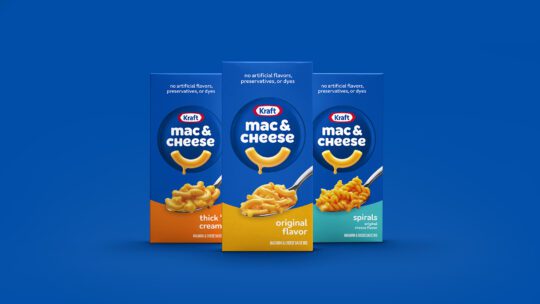
Say “31 flavors” to an ice cream enthusiast and she'll immediately point you in the direction of the closest Baskin Robbins. However, the 77-year-old company, while continuing to enjoy annual growth and an affable reputation, saw an opportunity to remain fresh and top-of-mind in an emerging market.
So, in April Baskin Robbins decided a slight re-do of its logo would garner attention and remind fans to “seize the yay,” its new tagline.
“Any rebrand communicates a message of change,” says Margo Kahnrose, CMO of Skai, an intelligent marketing platform. “Often that message is as simple as modernization, which has neutral undertones."
Kahnrose adds, "rebranding can be enough to call new attention to a stale or even just mainstay product with some PR buzz.”
Still, Baskin Robbins’ move may give others pause as they wonder about the rebrand's ROI.
A Landor study shows 74 percent of S&P 100 companies rebrand within a seven-year period, particularly if they've taken on a merger or acquisition. While Baskin Robbins’ rebrand came from a desire to modernize, other rebrands make a statement about positive change.
For example, Aunt Jemima, now Pearl Milling Company, chose to rebrand due to the name's racial stereotype.
How should organizations proceed and where can they look for results?
Deciding to Rebrand...
A rebrand should not be looked at as a quick fix for bad press or poor sales. Like any strategy, it requires research, planning and launching, as well as assessment and measurement. Entrepreneur says brands change their corporate identities once every seven to 10 years on average.
Clearly, patience is required. A full overhaul can take 12 to 18 months. It takes even longer than that before an organization sees results.
“A rebrand should be a last resort,” Kahnrose says. “It’s a tool in your brand’s box that can’t really be used many times—possibly only once—and it’s a hammer, not an Allen wrench!"
Says branding consultant Kelli Corney, former chief growth officer at ad agency Mightily, "a brand is one simple thing: the truth about who you are."
Because of the risk and amount of resources needed for rebranding, companies should be prepared for every possible outcome, much like preparing for crisis. Brands considering a rebrand, Kahnrose says, should know their objectives and expected impact.
“They need to very honestly weigh the possible upside against the potential for backlash and waste,” she adds. “It’s a no-brainer if your brand name excludes or trivializes a group of people. It’s an option for consideration if your revenue has been steadily declining AND you’ve conducted research that shows a correlation to brand associations. Another reason can be a wildly changed competitive landscape in which the power of your brand legacy works against, rather than for, you.”
A perennial dinnertime favorite, Kraft Macaroni & Cheese, recently announced its rebrand to Kraft Mac & Cheese. Similar to Baskin Robbins, one may question this tweak and ask, why go through the trouble? The decision reflected changes in the product's audience, according to Kraft. The revised name, Kraft says, "is meant to reflect the way fans organically talk about the brand."
Communication is Key
And how fans speak about a product is critical as is the way a company communicates with them. "Most companies actually understand their brands very well, they just fundamentally misunderstand how to communicate them," says branding consultant Kelli Corney, former chief growth officer at Mightily, an ad agency. "Without making a lot of expensive tactical changes, you can have a huge impact on your brand image by simply defining your voice and speaking in a specific, relatable language to your customers," Corney adds.
The Value in Communicating a Rebrand
As such, PR teams are critical to a successful rebrand. Part of PR's job is telling the public why a rebrand is needed. Doing so creatively is key.
As such, Dr. Dustin York, an associate professor of communication at Maryville University, says a rebrand should never occur without a redeveloped vision statement. “The new vision statement should be the talking point internally and externally via the media when unveiling the rebrand.”
York uses Uber as an example.
The company's founder, Travis Kalanick, was forced to resign in June 2017 over allegations of discrimination and sexual harassment in Uber's corporate culture. As a result, the public distrusted Uber. A 2018 rebrand was developed to spearhead a new company story "and visualize a commitment to change,” York says.
York also says companies can assess a rebrand by how well it communicates:
- Sustainability (how the brand is built for the future)
- Relevance (how stakeholders need it)
- Differentiation (specifically from competition)
And this communication can be done through creative talking points.
“Talking points should be created to speak to how the organization is poised to succeed in the future, the growing demand for the organization’s products or services in the marketplace, and how the organization excels over its competition using its brand positioning.” Internal and external employees, at all levels and departments, should be aware of these points.
Measuring a Rebrand
In 2019, Mastercard dropped its name from its logo. Many communicators and marketers believe this small change is one of the best rebrand campaigns ever. Dropping the word Mastercard, Kahnrose says, "implies the image needs no formal introduction—a powerful statement!—and sets the brand up to easily flex for application in the future of payments, which will be largely digital."
York says the design change helped Mastercard become iconic. He likens it to when Nike dropped its name from its logo, in 1995. "The iconic swoosh can be recognized in a split second in your peripheral, and easily tagged on any sized physical or digital element."
But labeling something iconic and recognizable doesn’t cut it when you are trying to determine an ROI for a rebrand. Kahnrose says the way to measure the ROI on a rebrand depends on your original reasons for doing it.
“If you’re trying to start fresh, or break into a new audience, before-and-after (and over time) measures of awareness among key audience segments will tell you whether the effort bore fruit,” she says.
If your goal is shifting brand awareness or perception, Kahnrose says to define “target attributes” and conduct a research study to “assess whether customers view you differently.” Check in again at a later date, but give it some time—at least six months to a year.
And finally if your goal is to react to negative press or remove an offensive name, Kahnrose says the strategy “should be around how to turn the negative publicity into positive return and capitalize.”
“Key performance indicators can include social media buzz, incremental sales lift post-rebrand, and audience penetration within the segment you’ve previously put off,” she says.
And before you start measuring, benchmark the “before” state of a brand, because like any branding effort, Kahnrose says “a rebrand should increase the ROI of all of your sales and marketing efforts.”
